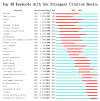A Bibliometric Insight of Genetic Factors in ASD: Emerging Trends and New Developments
- PMID: 33396229
- PMCID: PMC7824688
- DOI: 10.3390/brainsci11010033
A Bibliometric Insight of Genetic Factors in ASD: Emerging Trends and New Developments
Abstract
Autism spectrum disorder (ASD) cases have increased rapidly in recent decades, which is associated with various genetic abnormalities. To provide a better understanding of the genetic factors in ASD, we assessed the global scientific output of the related studies. A total of 2944 studies published between 1997 and 2018 were included by systematic retrieval from the Web of Science (WoS) database, whose scientific landscapes were drawn and the tendencies and research frontiers were explored through bibliometric methods. The United States has been acting as a leading explorer of the field worldwide in recent years. The rapid development of high-throughput technologies and bioinformatics transferred the research method from the traditional classic method to a big data-based pipeline. As a consequence, the focused research area and tendency were also changed, as the contribution of de novo mutations in ASD has been a research hotspot in the past several years and probably will remain one into the near future, which is consistent with the current opinions of the major etiology of ASD. Therefore, more attention and financial support should be paid to the deciphering of the de novo mutations in ASD. Meanwhile, the effective cooperation of multi-research centers and scientists in different fields should be advocated in the next step of scientific research undertaken.
Keywords: ASD; bibliometric; genetics; quantitative analysis; research frontiers.
Conflict of interest statement
All the authors declare that the research was conducted in the absence of any commercial or financial relationships that could be construed as a potential conflict of interest.
Figures







Similar articles
-
Bibliometric Insights in Advances of Anaplastic Thyroid Cancer: Research Landscapes, Turning Points, and Global Trends.Front Oncol. 2021 Nov 24;11:769807. doi: 10.3389/fonc.2021.769807. eCollection 2021. Front Oncol. 2021. PMID: 34900720 Free PMC article.
-
Bibliometric analysis of research trends of physical activity intervention for autism spectrum disorders.Front Hum Neurosci. 2022 Aug 12;16:926346. doi: 10.3389/fnhum.2022.926346. eCollection 2022. Front Hum Neurosci. 2022. PMID: 36034121 Free PMC article.
-
Bibliometric Insights in Genetic Factors of Substance-Related Disorders: Intellectual Developments, Turning Points, and Emerging Trends.Front Psychiatry. 2021 May 31;12:620489. doi: 10.3389/fpsyt.2021.620489. eCollection 2021. Front Psychiatry. 2021. PMID: 34135780 Free PMC article.
-
Bibliometric profile of the global scientific research on autism spectrum disorders.Springerplus. 2016 Sep 2;5(1):1480. doi: 10.1186/s40064-016-3165-6. eCollection 2016. Springerplus. 2016. PMID: 27652054 Free PMC article.
-
Trends in Autism Research in the Field of Education in Web of Science: A Bibliometric Study.Brain Sci. 2020 Dec 21;10(12):1018. doi: 10.3390/brainsci10121018. Brain Sci. 2020. PMID: 33371289 Free PMC article. Review.
Cited by
-
A bibliometrics analysis and visualization of autism spectrum disorder.Front Psychiatry. 2022 Jul 18;13:884600. doi: 10.3389/fpsyt.2022.884600. eCollection 2022. Front Psychiatry. 2022. PMID: 35923445 Free PMC article.
-
Bibliometric Insights in Advances of Anaplastic Thyroid Cancer: Research Landscapes, Turning Points, and Global Trends.Front Oncol. 2021 Nov 24;11:769807. doi: 10.3389/fonc.2021.769807. eCollection 2021. Front Oncol. 2021. PMID: 34900720 Free PMC article.
-
Decoding the genetic landscape of autism: A comprehensive review.World J Clin Pediatr. 2024 Sep 9;13(3):98468. doi: 10.5409/wjcp.v13.i3.98468. eCollection 2024 Sep 9. World J Clin Pediatr. 2024. PMID: 39350903 Free PMC article.
-
Gut microbiota and autism spectrum disorders: where do we stand?Gut Pathog. 2023 Oct 25;15(1):50. doi: 10.1186/s13099-023-00575-8. Gut Pathog. 2023. PMID: 37880713 Free PMC article.
-
Global Trends in Physical-Activity Research of Autism: Bibliometric Analysis Based on the Web of Science Database (1980-2021).Int J Environ Res Public Health. 2022 Jun 14;19(12):7278. doi: 10.3390/ijerph19127278. Int J Environ Res Public Health. 2022. PMID: 35742529 Free PMC article. Review.
References
-
- Association A.P. Diagnostic and Statistical Manual of Mental Disorders (DSM-5®) American Psychiatric Pub; Washington, DC, USA: 2013.
Publication types
Grants and funding
LinkOut - more resources
Full Text Sources
Research Materials
Miscellaneous

